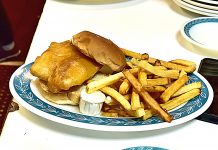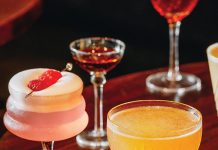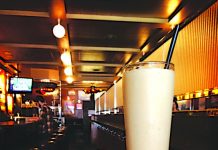
Metro Detroit is rich in gourmet emporiums and ethnic markets and restaurants. But once in awhile, there’s nothing like a little international travel to reignite the passion for food — even when that travel involves just an affordable one-day jaunt across the border to Windsor.
Earlier this season, we asked Rina Tonon, owner of Café Cortina in Farmington Hills, to give us a cook’s tour of that city’s Italian flavor.
The day begins at Tonon’s weekend pied-à-terre, a high-rise condo on the Windsor side of the Detroit River.
“Espresso?” she asks, as we stand admiring her spectacular view of the Detroit skyline, a panorama that stretches from the Ambassador Bridge to Belle Isle and beyond.
With the adept expertise of an Italian restaurateur and hostess, she quickly fills two blue-and-white china espresso cups and asks if we’d like our caffeine with a touch of sambuca, which makes, as the Italians say, “corrected coffee.”
Photographer Cybelle Codish and I glance at each other with looks that say, “But it’s 9:30 in the morning.” By then, Tonon has already added a splash of the anise-flavored liqueur, and we accept our cups with a “when in Rome,” sense of adventure.
Properly initiated, we climb into Tonon’s SUV and begin our day as novices trailing her into markets, where she greets shopkeepers with a cheery buon giorno before launching into bilingual conversations about cheese, sausage, and the merits of various canned tomatoes.
As she drives, we learn that Tonon was born in New York, in the Arthur Avenue neighborhood of the Bronx, which is like Little Italy, she says. On a recent vacation, she returned to Arthur Avenue, where, she says, “I had fresh clams on the street.”
Wherever Tonon goes, she seeks out the best local purveyors. That includes metro Detroit, of course, and ethnic markets such as Cantoro in Livonia.
She pulls into the parking lot of Giglio’s Market on Wyandotte Street, about three blocks from the Ambassador Bridge. Open since 1967, Giglio’s stock remains primarily Italian, but the store has become more international to accommodate the international student body at the University of Windsor.
Inside Giglio’s, it’s time for another cup of “corrected” espresso, along with samples of buttery-smooth prosciutto and spicy sausage made by shopkeeper Giuseppe Giglio. His son Domenic offers slices of pecorino canestrato and a fluffy ricotta. He suggests that aged balsamic is the “ultimate foodie gift,” and generally extols the virtues of eating Italian style. As proof, he mentions a November 2005 National Geographic story on longevity that cited Sardinians as being especially long lived. He keeps a copy of the issue behind the butcher counter.
After the tasting session, Tonon sweeps through the aisles of the tiny market, pointing to her favorites:
“Tomato paste in a tube — for when you need a little bit of concentrated paste — is a staple in my house.”
“I always cook with Aurora bouillon from Italy; I use mushroom bouillon for risotto — it gives it a kick.
“I always travel with Medaglia D’Oro Instant Espresso.”
Then it’s time to meet Tonon’s good friend Angie Soares at Windsor’s Farmers Market at Market Square on Ottawa Street, so it’s “ciao” to Giglio’s.
Windsor’s version of Detroit’s Eastern Market is a bustling feast of local produce. Tonon buys Swiss chard and dandelion greens, which she’ll blanch and sauté with garlic, olive oil, and lemon juice. “I grew up with that,” she says.
Moving along, she asks us, “Do you eat prickly pear cactus? Oh, my. You cut the ends off and then split it down the middle and roll it out of the skin. They’re seedy, but they’re so sweet and so good.” She finds one at a stall, requests a knife, and offers us slices as proof.
Then she buys honey crisp apples (“so juicy”) from Wally Simpson Orchards, fifth-generation farmers from the Leamington area.
Soares, a good cook in her own right, points out Romano’s, a farmers market counter that sells mostly items that can’t be transported across the border — meat, for example. But you can buy Galati cheese, which is made in Windsor. “The freshest ricotta comes from Galati’s,” Soares says. And, Tonon adds, “They sell it at Papa Joe’s and Nino Salvaggio.” Tonon completes her rounds by picking up one-and-a-half bushels of red peppers, which prompts a discussion with Soares about how best to freeze them after roasting. Tonon removes the skin. Soares barbecues the peppers and freezes them with the wrinkled skins intact.

Whatever the method, both agree that, after thawing, you just add olive oil, salt, pepper, garlic, and parsley.
It’s nearly time for lunch and Tonon is on her cell with Il Gabbiano, where owner Joe Fallea has agreed to serve a special lunch for her guests.
The route to the restaurant includes stops at Milena’s Bakery, La Stella Supermarket, and the Mediterranean Seafood Market.
At La Stella, Eugene Publiese, the owner for 40 years, claims the “biggest pasta aisle in Ontario.” There’s more cheese sampling, including Paron (made from sheep’s milk in Hamilton, Ontario).
Tonon points out canned light tuna packed in olive oil, saying, “I don’t know how people can eat it in water.”
At Il Gabbiano Ristorante on Erie Street East, which runs through the heart of Windsor’s Italian district, Fallea greets us on the sidewalk with his three young children in tow.
Inside the sunlit café, where tables are dressed in white linen, Fallea and his staff serve sparkling water, the house red, a lightly dressed green salad, and wonderfully satisfying porcini mushroom risotto that’s finished with truffle oil and shaved Parmesan.
“Spectacular,” Tonon announces. And that verdict came even before the heavenly tiramisu arrived with yet another espresso. The wine, the flavors, and the sense of being on vacation encourage wide-ranging conversation that begins with more talk of food.
“My aunt from Italy, she makes her own balsamic,” Soares says. “She boils her wine and adds vinegar. It was the best balsamic I ever had.”
“Because you were in Italy,” Tonon says. True. Travel whets the appetite and the hunger travels home with you as a pleasant souvenir.
Talk of making tomato sauce (remember a tiny bit of butter) turns to Italian tradition. “Italian women, when we got married, our husbands gave us the money and we saved,” Soares says. “You know, make a pot of lentil soup.”
Then Tonon steers the talk toward the relationship of Detroit and Windsor and the need to capitalize on the international cachet. “Little Windsor has a heart and soul made up of family people,” she says. We touch on politics, first ladies, finding good men, cruise vacations, and steamed lobster, until it’s time to leave for one more stop.
As we drive to Aurora Bakery, the street scene includes men at coffee-shop café tables; older women in proper skirts, blouses, and cardigan sweaters; and a well-dressed man beside his Ferrari. Our guides point out the Angolo Blue Café, with its bocce court, and the Sorrento, one of the enclaves oldest cafés, they say.
“A lot of Italian people still live here,” Soares says. “The Church [St. Angela] is here. Erie Street is here. They can walk to the market every day.”
We pull to the curb outside Aurora Bakery and find owner Joe Maria in the back room wearing a muscle shirt and looking a bit like Nicolas Cage (the baker) in the movie Moonstruck.
He’s known for making cassata, a ricotta cake for the “real Italian bride.” It’s almost like a cheesecake, he explains as he expertly frosts a sponge cake created from puff pastry dough like cannolis. “I’m Sicilian; I make European-style cakes,” he says. And then, as if he’d remembered his manners, he commands a young helper to fetch some cannolis for his visitors, explaining:
“You come into an Italian bakery and don’t have a cannoli, it’s like you go to Rome and don’t see the pope.” Exactly.
Crossing the Border
• You may bring bakery items and certain cheeses into the United States. Many prepared foods are admissible. However, almost anything containing meat products (bouillon or soup mixes, for example) are not allowed. As a general rule, condiments, vinegars, oils, packaged spices, honey, coffee, and tea are fine. Because rice can often harbor insects, it’s best to avoid bringing it into the United States.
• Bringing fruits and vegetables can be complicated. Fresh produce should bear a label indicating where it was grown. If you plan to bring fresh produce into the country, consider contacting customs at the Detroit-Windsor Tunnel or Ambassador Bridge in advance.
• The civil penalty for failing to declare agricultural items at U.S. ports of entry is $300 for first-time offenders.
• Many products mentioned in this story are approved for return to the United States. They include mushroom bouillon, fresh fish (up to 50 pounds for personal use), and pastries made at local Windsor bakeries.
• Regulations governing meat and meat products are very strict. Travelers may not import fresh, dried, or canned meats or meat products from most foreign countries into the U.S. Also, you may not import food products that have been prepared with meat.
• For more details about bringing goods into the country as well as general information about how to efficiently cross the border (personal identification, for example), visit cbp.gov and search “Know Before You Go.”
|
|
|









